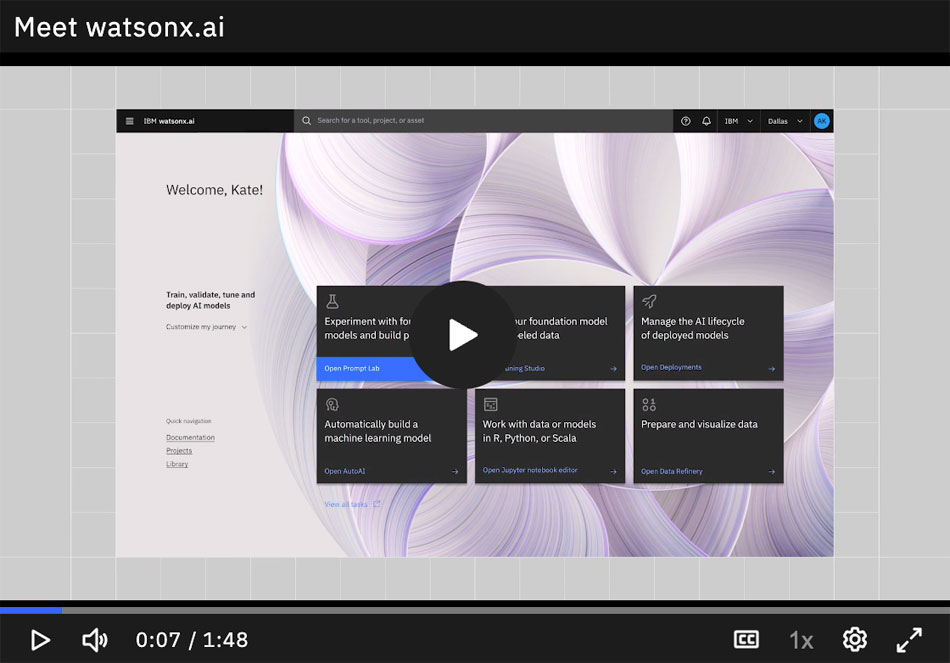IBL News | New York
IBM announced yesterday, at its annual Think conference, Watsonx, a new platform that gives customers access to the toolset, infrastructure, and consulting services to build their own AI models or fine-tune and adapt pre-trained models on their data for generating computer code, and text.
According to IBM, WatsonX is an “enterprise studio for AI builders,” motivated by the challenges businesses experience in deploying AI within the workplace. In the same category, Amazon provides SageMaker Studio; Google, Vertex AI; and Microsoft, Azure AI. Along with tech giants, startups like Cohere and Anthropic appear as competitors.
IBM is offering seven pre-trained models to businesses using Watsonx.ai, a few of which are open source. It’s also partnering with Hugging Face, the AI startup, to include thousands of Hugging Face–developed models, datasets, and libraries.
(For its part, IBM is pledging to contribute open-source AI dev software to Hugging Face and make several of its in-house models accessible from Hugging Face’s AI development platform.)
The three that the company is contributing are fm.model.code, which generates code; fm.model.NLP, a collection of large language models; and fm.model.geospatial, a model built on climate and remote sensing data from NASA.
Similar to code-generating models like GitHub’s Copilot, fm.model.code lets a user give a command in natural language and then builds the corresponding coding workflow. Fm.model.NLP comprises text-generating models for specific and industry-relevant domains, like organic chemistry. And fm.model.geospatial makes predictions to help plan for changes in natural disaster patterns, biodiversity, and land use, in addition to other geophysical processes.
IBM claims that the models are differentiated by a training dataset containing “multiple types of business data, including code, time-series data, tabular data and geospatial data and IT events data,” Arvind Krishna, the CEO of IBM, said in the roundtable.
IBM is using the models itself, it says, across its suite of software products and services. For example, fm.model.code powers Watson Code Assistant, IBM’s answer to Copilot, which allows developers to generate code using plain English prompts across programs including Red Hat’s Ansible.
As for fm.model.NLP, those models have been integrated with AIOps Insights, Watson Assistant, and Watson Orchestrate — IBM’s AIOps toolkit, smart assistant, and workflow automation tech, respectively — to provide greater visibility into performance across IT environments, resolve IT incidents in a more expedient way and improve customer service experiences — or so IBM promises.
FM.model.geospatial, meanwhile, underpins IBM’s EIS Builder Edition, a product that lets organizations create solutions addressing environmental risks.
Alongside Watsonx.ai, under the same Watsonx brand umbrella, IBM unveiled Watsonx.data, a “fit-for-purpose” data store designed for both governed data and AI workloads. Watsonx.data allows users to access data through a single point of entry while applying query engines, IBM says, plus governance, automation, and integrations with an organization’s existing databases and tools.
Complementing Watsonx.ai and Watsonx.data is Watsonx.governance, a toolkit that provides mechanisms to protect customer privacy, detect model bias and drift, and help organizations meet ethics standards.
In an announcement related to Watsonx, IBM showcased a new GPU offering in the IBM cloud optimized for compute-intensive workloads — specifically training and serving AI models.
The company also showed off the IBM Cloud Carbon Calculator, an “AI-informed” dashboard that enables customers to measure, track, manage, and help report carbon emissions generated through their cloud usage.
Around 30% of business leaders responding to an IBM survey cite trust and transparency issues as barriers holding them back from adopting AI, while 42% cited privacy concerns around generative AI.
IBM expects AI will add $16 trillion to the global economy by 2030 and that 30% of back-office tasks will be automated within the next five years.

 En Español
En Español






















